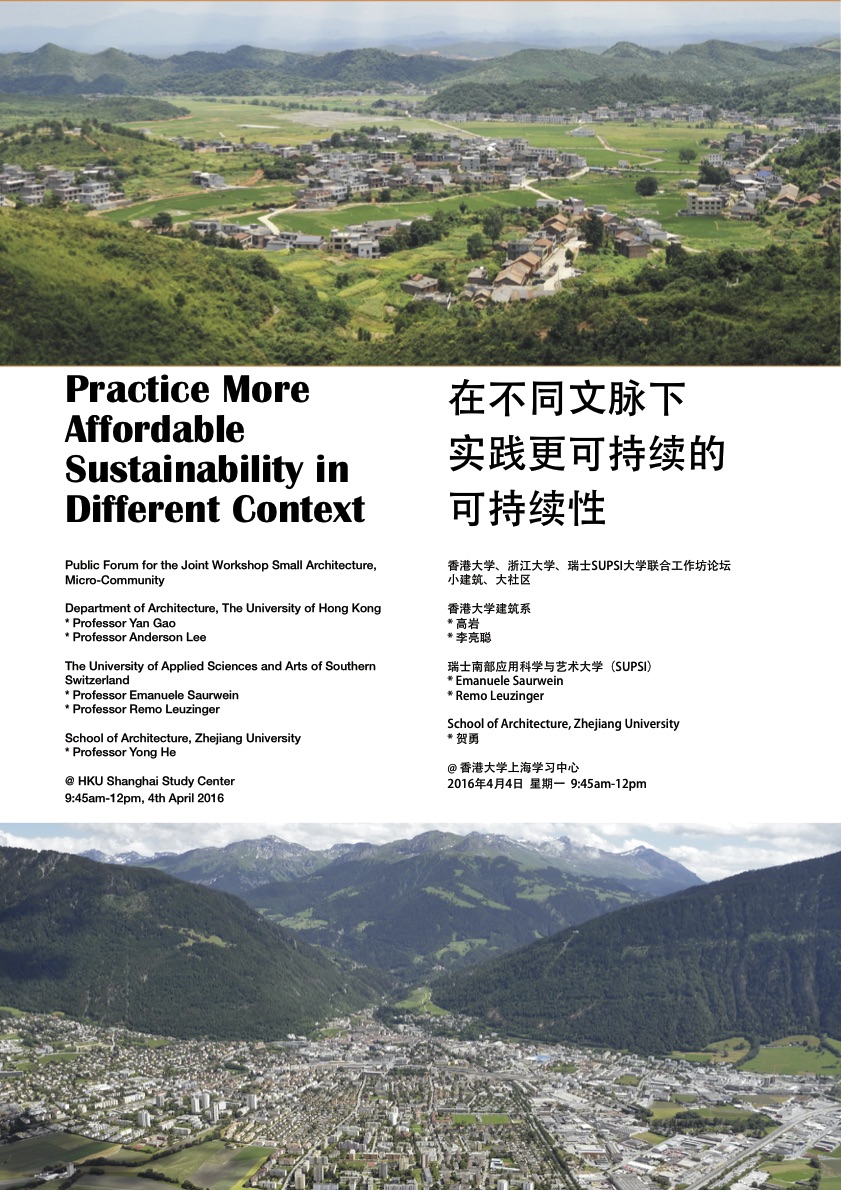4 April, Public Forum: Practice More Affordable Sustainability in Different Context
Public Forum for the Joint Workshop Small Architecture, Micro-Community
Topic: Practice More Affordable Sustainability in Different Context
Date: Monday, April 4, 2016 9:45AM – 12:00 PM
Venue: 1F Lecture Hall, Shanghai Study Center, HKU
Department of Architecture, The University of Hong Kong
Professor Yan Gao
Professor Anderson Lee
The University of Applied Sciences and Arts of Southern Switzerland
Professor Emanuele Saurwein
Professor Remo Leuzinger
School of Architecture, Zhejiang University
Professor Yong He
Professor Yunsheng Su
Partner of Etopia, Sino-Finish Center, Tongji University
Man Ye
Chairman of Tongji Green Building Council
Small Building, Micro-community
2016 workshop of Swiss SUPSI, Hong Kong University and Zhejiang University
Time: March 27, 2016 – April 1, 2016
Location: Dept. of Architecture, Zhejiang University
Topic: The Regeneration of the Gongchen Bridge Area of the Jinghang Grand Canal Through Small Intervention
Urban renovation is an urgent task nowadays and It’s necessary to reconstruct those parts in our cities that no longer fit with the modern society. Hangzhou is in the south end of the Grand Canal and has enjoyed great culture and economics ever since ancient times.
Gongchenqiao Area is located in Hangzhou, Gongshu district, west bank of the Grand Canal. It’s a typical combination of modern industry, civilian residence, and transportation culture, from Qing Dynasty to the early liberation of Hangzhou.
城市更新是当代中国社会和建筑学界共同面对的任务,是一种将城市中已经不适应现代化城市社会生活的地段做出的必要的、有 计划的改建活动。杭州地处京杭大运河最南端, 自古经济繁荣、人文昌盛,在空间维度和历史维度上有着研究的典型性。
拱宸桥地段(桥西历史街区)位于杭州市拱墅区,京杭大运河西岸。目前,该地段是集中体现杭州清末至解放初期依托运河而形 成的近代工业文化、平民居住文化及仓储运输文化的代表性复合型历史街区,是集居住、商业、创意产业和文化旅游为一体的城市综合区域。
The renovation of Gongchenqiao Area started in 2008 and ended in 2010. Based on investigation and research on its culture and history, the historic blocks are refreshed from three aspects as protection, exploration, and utilization, aiming to protect its diversity, authenticity and entirety. This area now represents historic culture and industrial heritage in Hangzhou. However, there still remain problems, such as traffic organization, format development, public living place, allocation of public facilities and so on, which need further enhancement.
拱宸桥历史文化街区(即桥西历史街区)的更新与改造始于 2008 年,该项目在规划设计之初,以保护桥西历史街区的景观建筑风貌的多样性和历史文化的多元化为前提,以保护桥西历史环境的原真性和整体性为基础,在对桥西历史人文的调查和现场的调查勘测的基础上,从保护、发掘、利用三个方面出发对桥西历史街区进行保护、更新与改造。该项目于 2010 年基本完工,目前,该地段已是杭州极具代表性的历史文化和工业遗存活化的街区,但是依然 也存在不少问题, 诸如交通的组织、业态的发展、市民生活场所的营造、公共设施的配置与使用等诸多方面都依然需要进一步的完善与提升。
Purposes to gain in this workshop from following aspects:
1) Theoretical Level: Organize the history and status of Gongchenqiao Area systematically. Understand the status, characteristics and problems of city renovation in current contexts.
2) Strategy Level: Explore how to create dynamic “micro communities” by implanting small public service facilities from the perspective of people’s daily life. Discuss the possibility and strategy for further activation, transformation and development.
3) Construction Level: Improve cognition on materials and construction. Understand methods and technology by design and construction of small facilities.
基于这样的背景,本次工作坊教学旨在达到以下几个方面的目的:
(1)理论认知层面:系统梳理拱宸桥地段发展的历史及更新的现状,帮助学生在中国城市建设进入理性化发展阶段的大背景下更深刻地理解城市更新的现状、特征与问题。
(2)发展策略层面:京杭大运河拱宸桥地段已经具有独特的文化底蕴、城市脉络和场地条件,本工作坊教学期待学生从市民日常 生活的视角,探讨如何通过系列小型公共服务设施的介入,营造出具有活力的“微型社区”,以此探讨其未来在城市功能方面进一步激活、转型和发展的可能与策略。
(3)建造层面:通过适当阐明材料选择、形式逻辑、操作过程, 提高学生对材料和构造的直观认识,理解小型设施设计与营建的手段与技术。
